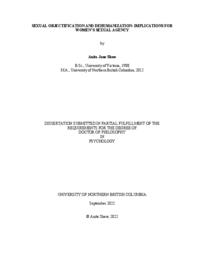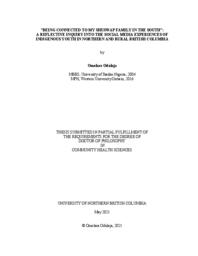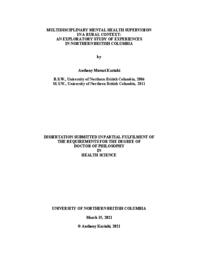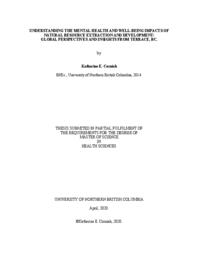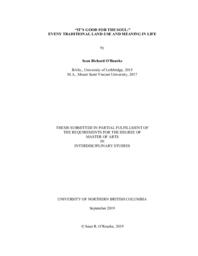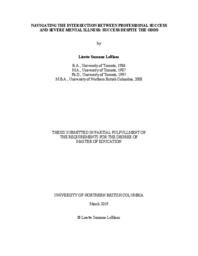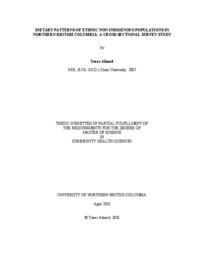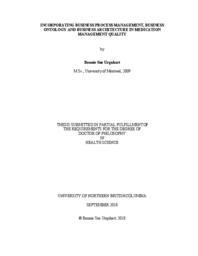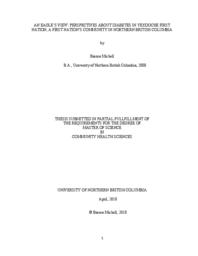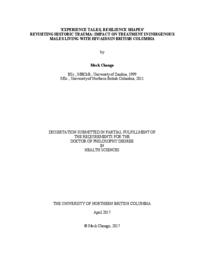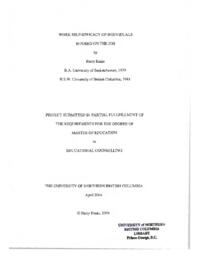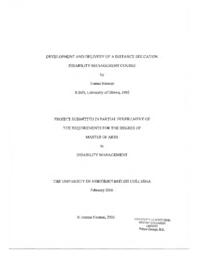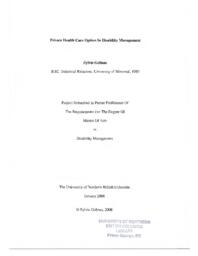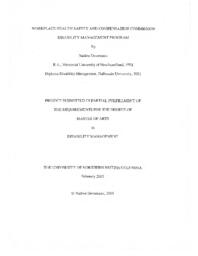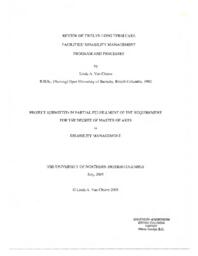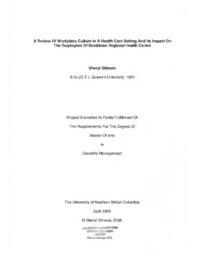Harder, Henry
Person Preferred Name
Henry Harder
Related Works
Content type
Digital Document
Description / Synopsis
While ideally sexual activities would only take place when mutually desired, many women participate in sex that they do not want. During their lifetimes, between 18% and 25% of women will experience rape or attempted rape, and 50% or more will experience some form of unwanted sexual activity (Gavey & Senn, 2014). The present research tests whether women’s ability to exercise sexual agency is undermined when her internal sense of humanness has been diminished by others thinking of and treating her like an object. In patriarchal cultures, women are chronically sexually objectified: represented as sexual objects, existing primarily for men’s sexual use. Conceptually, objectification implies dehumanization and previous research has found that when people evaluate another person’s appearance, they dehumanize women but not men (Heflick et al., 2011). When women or men are dehumanized by others, they self-dehumanize (i.e., experience diminished human characteristics and feel more object-like) (Andrighetto et al., 2018; Baldissarri et al., 2017; Bastian & Haslam, 2010; Loughnan et al., 2017) and experience diminished agency (Andrighetto et al., 2018; Baldissarri et al., 2017). Building on this previous research, the present research has two goals. Study 1 tests whether women are more commonly viewed as less human than men. In Study 2, experiences of being dehumanized were then examined as a cause of diminished agency (self-reported self-efficacy and sexual agency) due to self dehumanization. Women and men do not experience dehumanization equally. When people focus on another person’s appearance, women are viewed as less human than men; when instructed to focus on their performance or on them as a person, women and men are not viewed differently (Heflick et al., 2011). The conclusion from this research was that women are viewed as less human than men when the focus is on their appearance. Study 1 of the present research tested an alternate hypothesis: that women are generally viewed as less human than men except when the focus is on their personhood. Before viewing a video featuring either a woman or a man, participants were either given no instructions or were asked to focus on one of three things: the subject’s appearance; the subject as a person; or the video. Consistent with the hypothesis, when given no instructions, participants viewed the women as less human than the men (i.e., lower on competence and human characteristics). Study 2 then examined whether being dehumanized impacts women’s sense of their own humanness and, consequently, their sense of agency. After recalling either an experience of having their appearance evaluated by others or an experience of being treated primarily as an instrument in the workplace, women and men rated their internal feelings of humanness. Moderated mediation analyses demonstrated that both situations caused women and men to self-dehumanize and in turn report lower self-efficacy. Contrary to predictions, however, self-dehumanization did not diminish either women’s or men’s sexual agency. Challenges examining sexual agency are discussed.
Origin Information
Content type
Digital Document
Description / Synopsis
This research extends and explores two key concepts. First, cultural preservation is important to Indigenous health and wellbeing. Second, when Indigenous youth spend quality time (whether online or offline) on issues pertaining to their identity and sense of self, that time can be key to preserving Indigenous cultures. This research project was an exploratory study carried out using a variety of research methods, including online surveys, semistructured interviews, and open ended storytelling engagements. In this study, youth ages 15 to 24 years interacted with one another in online and offline spaces, which in some cases served as culturally safe wellbeing sites where their self-esteem increased, especially if they were mentored by Indigenous peers and adults. This study found out that Indigenous youth are active social media users and engage in all kinds of activities including self presentation, social connections, cultural activities, and advocacy. The risks and benefits of using social media for identity expression and cultural engagement were identified, but some youth were noted to require supports to engage safely on social media to derive maximum benefits. The interdisciplinary nature of the research merges concepts, theories, and ideas from First Nations Studies, Sociology, Community Health, and Media Studies. This project embraced methodologies employed in these various disciplines but used a Two-Eyed Seeing framework as a tool to ensure cohesiveness in the research and respect for Indigenous cultures and cultural protocols. The research ultimately unfolded using lenses of both Indigenous and nonIndigenous worldviews, which I believe contributed greatly to the richness of the findings.
Origin Information
Content type
Digital Document
Description / Synopsis
The purpose of this study was to better understand how multidisciplinary mental health supervision might work in rural remote settings. There is a need for supervisory approaches that address the unique contextual challenges in rural and remote multidisciplinary service delivery, such as management approaches, isolation, and lack of support. This study focused on three areas linked to multidisciplinary mental health supervision: challenges and opportunities, role perception, and differences in approaches. This study also attempted to reconcile the core supervisory requirements with the contextual challenges. The few studies on rural remote supervision have primarily focused on general internal and external factors facing rural remote professionals. Despite its importance, knowledge of how multidisciplinary rural remote supervisors perceive and/or appreciate their roles is limited. This study was informed by social construction and symbolic interaction theories, and guided by three research questions: 1) What challenges and opportunities do mental health supervisors experience in northern British Columbia? 2) How do frontline workers, supervisors, and senior managers perceive the roles and activities of mental health supervisors in northern British Columbia? 3) How are supervisory approaches in various mental health disciplines different or similar in northern British Columbia? The research methodology was qualitative and the study design adopted an interpretive, social interactionist approach. Source triangulation enhanced both the credibility and transferability of the findings. The sources included three participant groups: frontline mental health workers, mental health supervisors, and senior mental health managers. Another triangulation source was the context and setting review of BC’s complex mental health jurisdictions. Triangulation was also achieved by interviewing participants who worked in different settings, organizations, and geographic locations. Thematic analysis was used for data analysis resulting in 11 manifest themes and the following five latent themes: Difficult, overwhelming responsibilities; stressful, complicated decision making; the endless campaign for professional leadership support; mentorship in remote practice; and a struggle in collaborative plurality. Most of the participants expressed the wish for more support in their professional work. The findings from this study provide employers with new insights into multidisciplinary supervisory work and also emphasize the need for practical and specific ideas for much needed support for rural remote supervisors.
Origin Information
Content type
Digital Document
Description / Synopsis
Background: The prevalence of Alzheimer’s disease (AD) and other dementias is perpetually increasing in Canada and worldwide with the aging baby boomer population. It is, therefore, important to identify risk factors for these major neurocognitive disorders, such as alcohol consumption, to mitigate the future burden on caregivers and the economy. The purpose of this study was to replicate previous research regarding the dose-response relationship between alcohol consumption and the odds of currently having AD or another dementia. The possibility of a sex effect moderating this relationship was also explored. Participants: Data were obtained for respondents to the combined 2015/16 cycles of the Canadian Community Health Survey who were aged 41 years or older at the time of the survey’s conduction (nweighted = 16,715,618). Methods: Logistic regression was used to crossectionally assess the relationship between various time- and frequency-related alcohol consumption exposures to outcome dementia status, while controlling for a number of demographic and risk factor variables. Results: A sex effect was identified for drinking at an average frequency of four to six times per week over the past year (p = 0.019, 95% CI: 0.03, 0.73) where women (ORw = 0.13) were more protected against currently having AD or dementia than men (ORm = 0.89) when compared to alcohol abstainers. Binge drinking two to three times per month (OR = 0.19, p = 0.015, 95% CI: 0.05, 0.73) and more than once per week over the past year (OR = 0.16, p = 0.007, 95% CI: 0.04, 0.61) significantly lessened the odds of currently having AD or dementia when compared against alcohol abstainers. A sex effect was present for those who were classified as very heavy drinkers (♂: 6+ drinks/day, ♀: 4+ drinks/day) over the past week (p = 0.018, 95% CI: 1.14, 39.41) where alcohol was protective against currently having AD or dementia in men (ORm = 0.29) and alcohol was a risk factor for currently having AD or dementia in women (ORw = 2.15) when both were referenced with alcohol abstainers. Conclusions: With the exception of very heavy drinker women, drinking alcohol was associated with a reduced likelihood of currently having AD or dementia and sex effects were identified for drinking at a moderate frequency over the past year and very heavy drinkers. However, these results should be interpreted with caution due to the possibility of selection, sparse data, and abstainer biases as well as misclassification error. The primary implication of this research is to inform future studies that a more thorough exploration of a sex effect influencing the relationship between alcohol consumption and having AD or dementia is warranted.
Origin Information
Content type
Digital Document
Description / Synopsis
This research couples a global scale targeted systematic review with the perspectives and experiences of mental health service providers in Terrace, British Columbia. A targeted systematic review was conducted exploring mental health and well-being impacts of resource extraction globally. Findings informed qualitative interviews with mental health service providers in Terrace, BC. Main themes from service providers are systemic issues in health care, poor access to mental health services for children and youth, mental health risk factors, social determinants of health, and industry’s lasting influence and legacy. Synthesis of the findings from the systematic review and interviews with service providers indicates providers concerns aligned with the global literature. A synthesis combines the two phases of research. Insights from this work suggest a greater consideration of the social and mental health impacts of industrial projects is necessary, and there is need for equitable access to mental health resources for all ages.
Origin Information
Content type
Digital Document
Description / Synopsis
Following Russian/Soviet colonization, Indigenous Siberian Eveny less frequently engage in hunting and reindeer herding—land-based activities central to their culture. Research suggests that an inability to engage in key cultural activities may hamper Indigenous peoples’ capacities to construct meaningful existences (i.e., fulfilling lives with purpose), but this has not been empirically investigated among Eveny. I conducted 14 semi-structured interviews on traditional land-use and meaning in life with Eveny men in Batagay-Alyta (Sakkyryr), Sakha Republic (Yakutia), Russia. Half of the participants lived in the village; the other half were nomadic herders. Both herders and non-herders described meaningful existences, but the groups often acquired meaning from different sources. Some sources (i.e., family, finances, reindeer) were deemed important by both groups. My findings illuminate what makes life meaningful for some Eveny, and can help policy-makers better address their unique needs.
Origin Information
Content type
Digital Document
Description / Synopsis
This research used a mixed-method approach to examine motivational factors contributing to Aboriginal student retention at the University of Northern British Columbia. To explore academic motivation in the context of Self-Determination Theory, 20 Aboriginal participants completed in-depth interviews. The participants also completed an acculturation questionnaire to explore whether cultural orientation was an interceding factor in academic motivation. Five intriguing findings emerged from the data. First, Aboriginal students were motivated to succeed by the desire to contribute to the well-being of the participants’ home Aboriginal community, or to the broader Aboriginal community. Second, the participants viewed a university education as a means to self-growth, which they perceived as necessary to fulfill a needed role in the Aboriginal community. Third, home community support and institutional support were important factors in motivating students to stay in university and earn a degree. Fourth, participants perceived that their university experience supported their autonomy. Finally, in comparison with more acculturated participants, less acculturated participants were more likely to feel academically unprepared for university, were more likely to attend post-secondary education transition programs, were more likely to use academic resources at the university, and were more likely to return to their home Aboriginal community after graduation. This research showed that Self-Determination Theory, traditionally tested using quantitative methods, can be effectively explored using a qualitative approach. This research also showed that examining cultural orientation within a motivational framework contributes to our understanding of the influence of cultural dynamics on academic motivation in Aboriginal student populations.
Origin Information
Content type
Digital Document
Description / Synopsis
Hadiksm Gaax di waayu, I belong to the Ganhada (Raven Clan) and my Mother’s side of the family is from Gitxaala, we follow our Mothers. This research, writing, and data collection was done on the traditional unceded territories of the Tsimshian, Lheidli T’enneh, and Musqueam. This work was done in partnership with the people who shared their stories with me, the co-researchers, whose words provide a brief glimpse into the lived experience of First Nations identity and the thought processes involved in contemplating several sources of input informing how we think about identity. Stories of identity, perceptions of identity, and experiences of racism and discrimination have inspired this work and highlighted the need for engagement. This research is a validation of thought processes that surround how we, First Nations people, experience identity. A shift away from Western conceptualizations of identity, this research discusses experiential knowledge, racism and discrimination, impacts of racial microaggressions on self-perceptions and health, and a sampling of how some people have come to define their identity in their own way based on their experiences. The intent of this work is to both inform those who may not understand and to acknowledge and validate those who have thought about First Nations identity but do not have a safe space to share. I hope this work speaks to both First Nations and non-First Nations/Settler Canadians as we continue learning about one another and sharing with each other in the spirit of reconciliation.
Origin Information
Content type
Digital Document
Origin Information
Content type
Digital Document
Origin Information
Content type
Digital Document
Origin Information
Content type
Digital Document
Origin Information
Content type
Digital Document
Origin Information
Content type
Digital Document
Origin Information
Content type
Digital Document
Origin Information
Content type
Digital Document
Origin Information
Content type
Digital Document
Origin Information
Content type
Digital Document
Origin Information
Content type
Digital Document
Origin Information
Content type
Digital Document
Origin Information
Content type
Digital Document
Origin Information
Content type
Digital Document
Origin Information
Content type
Digital Document
Origin Information

